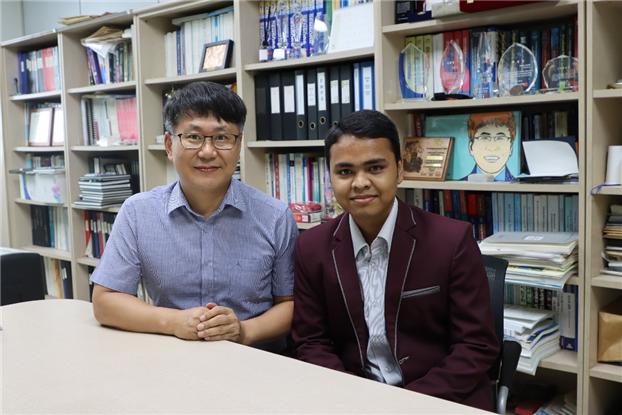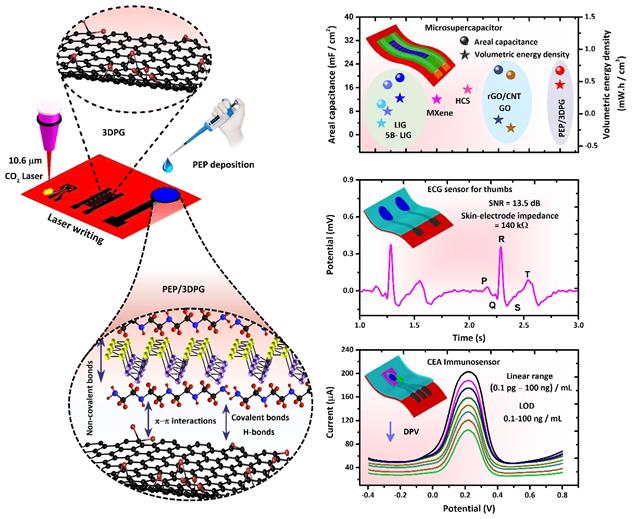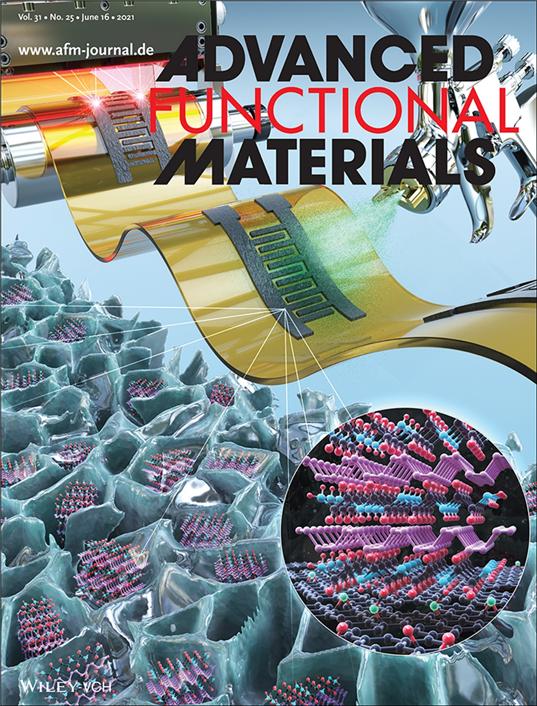Prof. Park Jae-Young’s Team Develops a Cancer Diagnosis Sensor Using 3D Porous Graphene
- admin
- 2021-11-18
- 2544
Prof. Park Jae-Young’s Team Develops a Cancer Diagnosis Sensor Using 3D Porous Graphene
Professor Park Jae-Young's research team (Department of Electronic Engineering) has succeeded in developing a three-dimensional porous graphene flexible electrode material with excellent mechanical, electrical and chemical performance, which is a key technology for the development of various wearable medical/healthcare sensors and energy storage devices. The developed technology is evaluated as a technology with high commercialization potential because it can produce materials and devices using only laser processing and coating technology, which enables low cost and mass production.

Professor Park Jae-Young (left) and Ph.D. student Abu doctoral (right)?
Recently, due to the unique structure, excellent thermal conductivity, high surface area, and excellent electrical conductivity of 3D porous graphene (3DPG) electrode material fabricated with a laser, research for application and utilization in the field of biosensors and energy storage devices has been conducted. A lot is being done however, three-dimensional porous graphene flakes made with laser processing technology have unstable interconnections, so their electrical conductivity is not constant, and their mechanical strength is weak, so there is a limit as a commercial technology.
In addition, when the sensor and energy storage element using the same were repeatedly bent, structural deformation was greatly induced, and electrical conductivity was greatly reduced. In order to solve this problem, studies have been conducted to coat 3D porous graphene with phosphorane (Ph), a 2D nanomaterial with excellent mechanical flexibility and biocompatibility, but this material deteriorates in performance and structurally when exposed to the external environment. Because it is easily damaged and there is no active functional group, there has been a limit to realizing a sensor and energy storage device with excellent performance.
Accordingly, Professor Park Jae-Young's team successfully solved the problems of non-uniform electrical conductivity and easily broken or deformed structures by coating phosphorine encapsulated with polyaziridine (PAZ) on three-dimensional porous graphene. The non-covalent encapsulation technique using polyaziridine (PAZ) was very effective in alleviating the instability of phosphorine upon environmental exposure, self-aggregation and re-stacking, lack of active functional groups, and coffee ring effect. In addition, the electrochemical properties and surface-active functionality of the electrode material were greatly improved through the bridging effect linking 2D phosphorene and 3D porous graphene.
In addition, the research team has successfully developed a high-performance wearable cancer diagnostic sensor, electrocardiogram (ECG) sensor, and micro supercapacitor using a three-dimensional porous graphene flexible electrode material coated with phosphorin encapsulated with polyaziridine. The cancer diagnostic sensor showed a linear range of 0.1-700 pgmL-1 and 1-100 ngmL-1, a detection limit of 0.34 pgmL-1, and high selectivity. The finger touch-based ECG sensor showed relatively low and stable impedance at the skin electrode interface, and the measured signal-to-noise ratio (13.5 dB) of the sensor was similar to that of the Ag/AgCl commercial electrode (13.9 dB) sensor. In addition, the micro supercapacitor exhibited excellent capacitance characteristics of 16.94mF cm-2. These results proved that the excellent properties of the three-dimensional porous flexible electrode material developed in this study and the manufacturing process technology capable of mass production can be widely used in various industrial fields.
Meanwhile, this research was carried out with support from the National Research Foundation of Korea Biomedical Technology Development Project (NRF-2017M3A9F1031270) and the Ministry of Trade, Industry and Energy's Nano Convergence Industry Core Technology Development Project (20000773). The research results were published as a cover paper in the June 2021 issue of Advanced Functional Materials (IF:18.808) published by Wiley, Germany, the world's leading journal dedicated to research on functional materials and devices.
https://doi.org/10.1002/adfm.202009018

Concept diagram of high-performance 3D porous graphene electrode and performance of the manufactured cancer diagnostic sensor, electrocardiogram sensor, and micro supercapacitor

Cover published in Advanced Functional Materials